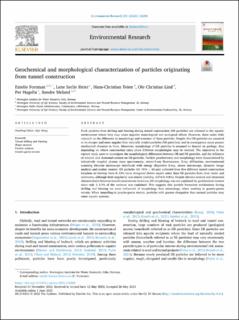| dc.description.abstract | Rock particles from drilling and blasting during tunnel construction (DB particles) are released to the aquatic environment where they may cause negative toxicological and ecological effects. However, there exists little research on the difference in morphology and structure of these particles. Despite this DB particles are assumed to be sharper and more angular than naturally eroded particles (NE particles), and in consequence cause greater mechanical abrasion to biota. Moreover, morphology of DB particles is assumed to depend on geology, thus depending on where construction takes place different morphologies may be emitted. The objectives in the current study were to investigate the morphological differences between DB and NE particles, and the influence of mineral and elemental content on DB particles. Particle geochemistry and morphology were characterized by inductively coupled plasma mass spectrometry, micro-X-ray fluorescence, X-ray diffraction, environmental scanning electron microscope interfaced with energy dispersive X-ray, stereo microscope, dynamic image analysis and coulter counter. DB particles (61–91% < 63 μm) collected from five different tunnel construction locations in Norway were 8–15% more elongated (lower aspect ratio) than NE particles from river water and sediments, although their angularity was similar (solidity; diff 0.3–0.8%). Despite distinct mineral and elemental characteristics between tunnel construction locations, DB morphology was not explained by geochemical content since only 2–2.1% of the variance was explained. This suggests that particle formation mechanisms during drilling and blasting are more influential of morphology than mineralogy, when working in granite-gneiss terrain. When tunnelling in granite-gneiss terrain, particles with greater elongation than natural particles may enter aquatic systems. | en_US |

